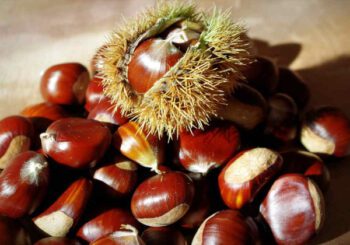By Sayer Ji
Contributing Writer for Wake Up World
Chestnuts roasting on an open fire might as well be a timeless image of Christmas. These nuts, coming from the Castanea genus family, deliver a slight sweetness along with a nutty crunch and the flexibility to be added to salads and soups, stuffing and many other dishes.
[pro_ad_display_adzone id=”110028″]
Sweet chestnuts are often called the “bread tree,” serving as a staple food and source of nutrition for people in the Mediterranean and Europe.[i] Widely recognized for their nutritional value, these nuts provide carbohydrates, vitamins, minerals, fiber and protein, to name a few. Here are five extraordinary benefits of chestnuts for human health.
1. Better Memory
Nuts in general are lauded for their highly nutritious profile. In particular, they are studied for combating oxidative damage, inflammation, the aging process and dementia or memory loss.[ii]
A 2020 review looked at the anti-dementia property of nine different nuts, including chestnuts. Of nuts’ rich nutritional profile, essential fats, proteins, vitamins, fibers, minerals and trace elements stand out. These properties and more “can make nuts an alternate therapy for humankind to fight against memory loss,” the authors wrote.
2. Improved Heart Health
Chestnuts offer nutrients that assist in cardiovascular wellness. They are rich antioxidants, namely gallic and ellagic acids, which have been found to help protect the heart from oxidative stress.[iii],[iv] This condition may increase the risk of strokes as well as heart disease.
Chestnuts also provide a good amount of potassium, a mineral that helps keep the heart healthy and regulate blood pressure levels.[v]
3. Potential Diabetes Fighter
Consuming nuts, including chestnuts, has been linked to protection against Type 2 diabetes and related metabolic syndromes.[vi] This benefit is connected to reduced oxidative damage as well as inflammatory biomarkers, along with chestnuts’ beneficial fatty acids, dietary fibers, vegetable proteins and polyphenols.
This is where the rich antioxidant profile of chestnuts comes in: these compounds help protect cells against damage caused by unstable molecules known as free radicals. Oxidative stress can raise the risk of chronic illness such as diabetes, heart disease and various types of cancer.[vii],[viii]
4. Weight Loss
The high fiber content of chestnuts is instrumental in keeping you feeling fuller for longer. This is because fiber helps delay the time it takes for food to go from the stomach into the intestines.[ix] Animal studies also suggest that dietary supplementation with chestnuts may reduce abdominal fat.[x]
5. Anticancer Action
A 2014 study suggested that the Castanea mollissima Blume, also known as Chinese chestnut, contains flavonoids and polyphenolic acids that possess anticancer properties and may protect against diabetes complications.[xi] In test-tube research, the antioxidants in these nuts helped suppress the growth as well as spread of cancer cells, such as prostate cancer.[xii],[xiii]
How to Use Chestnuts
It’s easy to add chestnuts to your diet. You may eat them raw, although their high tannin content may lead to digestive problems in sensitive individuals. You may also boil or roast chestnuts. Once cooked, their skin becomes easy to remove for healthy, delicious snacking or as stuffing in festive dishes.
Don’t miss out on the standout health benefits of chestnuts and other nuts with hundreds of abstracts on the GreenMedInfo.com database.
Sources and References:
[i] Dos Santos Rosa E et al “Uses and Health Benefits of Chestnuts” 28 Jul 2019.
[ii] Arslan J et al “Edible Nuts for Memory” Curr Pharm Des. 2020 ;26(37):4712-4720.
[iii] Akbari G “Molecular mechanisms underlying gallic acid effects against cardiovascular diseases: An update review” Avicenna J Phytomed. Jan-Feb 2020;10(1):11-23.
[iv] Larosa M et al “Ellagitannins, ellagic acid and vascular health” Mol Aspects Med. 2010 Dec;31(6):513-39. doi: 10.1016/j.mam.2010.09.005. Epub 2010 Sep 15.
[v] Burnier M et al “Should we eat more potassium to better control blood pressure in hypertension?” Nephrol Dial Transplant. 2019 Feb 1;34(2):184-193.
[vi] Dos Santos Rosa E et al “Uses and Health Benefits of Chestnuts” 28 Jul 2019.
[vii] Pham Huy L et al “Free radicals, antioxidants in disease and health” Int J Biomed Sci. 2008 Jun;4(2):89-96.
[viii] Zhang Y et al “Antioxidant Phytochemicals for the Prevention and Treatment of Chronic Diseases” Molecules. 2015 Nov 27;20(12):21138-56.
[ix] Yu K et al “The impact of soluble dietary fibre on gastric emptying, postprandial blood glucose and insulin in patients with type 2 diabetes” Asia Pac J Clin Nutr. 2014;23(2):210-8.
[x] Biomedicines. 2020 Apr 4;8(4):75.doi: 10.3390/biomedicines8040075. https://pubmed.ncbi.nlm.nih.gov/32260459/
[xi] Zhang L et al “Extracts and compounds with anti-diabetic complications and anti-cancer activity from Castanea mollissina Blume (Chinese chestnut)” BMC Complement Altern Med. 2014 Oct 28;14:422.
[xii] Nascimento-Gonçalves E et al “The influence of Castanea sativa Mill. flower extract on hormonally and chemically induced prostate cancer in a rat model” Food Funct. 2021 Mar 21;12(6):2631-2643.
[xiii] Cacciola N et al “Untargeted Characterization of Chestnut ( Castanea sativa Mill.) Shell Polyphenol Extract: A Valued Bioresource for Prostate Cancer Cell Growth Inhibition” Molecules. 2020 Jun 12;25(12):2730.
About the author:
Sayer Ji is the founder of Greenmedinfo.com, a reviewer at the International Journal of Human Nutrition and Functional Medicine, Co-founder and CEO of Systome Biomed, Vice Chairman of the Board of the National Health Federation, and Steering Committee Member of the Global Non-GMO Foundation.
© 2020 GreenMedInfo LLC. This work is reproduced and distributed with the permission of GreenMedInfo LLC. Want to learn more from GreenMedInfo? Sign up for their newsletter here.
[pro_ad_display_adzone id=”110027″]









